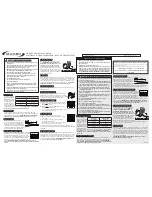
5
ETM–949 | ETM–949EVS
7.
Wear ear protectors (plugs or muffs) during extended periods of operation.
8. Do not operate this machine while tired or under the influence of drugs, alcohol or any medication.
9. Make certain the switch is in the OFF position before connecting the machine to the power supply.
10. Make certain the machine is properly grounded.
11. Make all machine adjustments or maintenance with the machine unplugged from the power source.
12.
Remove adjusting keys and wrenches. Form a habit of checking to see that keys and adjusting wrenches are re-moved from the
machine before turning it on.
13.
Keep safety guards in place at all times when the machine is in use. If removed for maintenance purposes, use extreme caution
and replace the guards immediately.
14.
Some coolants used for machining contain chemicals that may be hazardous to your health if not used properly. Read and
understand all information on the coolant container and protect yourself accordingly.
15.
Check damaged parts. Before further use of the machine, a guard or other part that is damaged should be carefully checked to
determine that it will operate properly and perform its intended function. Check for alignment of moving parts, binding of moving
parts, breakage of parts, mounting and any other conditions that may affect its operation. A guard or other part that is damaged
should be properly repaired or replaced.
16.
Do not use power tools in damp/wet locations or other dangerous environments. Do not expose them to rain. Keep work area well
lighted. Provide for adequate space surrounding work area and non-glare, overhead lighting.
17. Keep work area and the floor around the machine clean and free of scrap material, oil and grease.
18.
Keep visitors a safe distance from the work area. Keep children away. Workshop should be childproof; padlocks, master switches,
remove starter keys.
19.
Give your work undivided attention. Looking around, carrying on a conversation and “horse-play” are careless acts that can result
in serious injury.
20.
Maintain a balanced stance at all times so that you do not fall or lean against the cutters or other moving parts. Do not overreach
or use excessive force to perform any machine operation.
21.
Use the right tool at the correct speed and feed rate. Do not force a tool or attachment to do a job for which it was not designed.
The right tool will do the job better and more safely.
22. Use recommended accessories; improper accessories may be hazardous.
23.
Maintain tools with care. Keep cutters sharp and clean for the best and safest performance. Follow instructions for lubricating and
changing accessories.
24.
Turn off the machine and disconnect from power before cleaning. Use a brush or compressed air to remove chips or debris — do
not use your hands.
25. Do not stand on the machine. Serious injury could occur if the machine tips over.
26.
Never leave the machine running unattended. Turn the power off and do not leave the machine until it comes to a complete stop.
27. Remove loose items and unnecessary work pieces from the area before starting the machine.
28.
Clamp workpiece or brace against column to prevent rotation. For safety and use of both hands, use clamps or a vise to hold work
when practical.
29. Use recommended speed for drill accessory and workpiece material.
30. Direction of feed — feed work into a blade or cutter against the direction of rotation of the blade or cutter only.
31.
Installation work and electrical wiring must be done by qualified electrician in accordance with all applicable codes and standards.
WARNING:
This product can expose you to chemicals including lead which is known to the State of California to cause cancer
and birth defects or other reproductive harm, and ethylbenzene which is known to the State of California to cause cancer. For
more information go to http://www.p65warnings.ca.gov.
WARNING:
Some dust, fumes and gases created by power sanding, sawing, grinding, drilling, welding and other construction
activities contain chemicals known to the State of California to cause cancer and birth defects or other reproductive harm. Some
examples of these chemicals are:
•
lead from lead based paint
•
crystalline silica from bricks, cement and other masonry products
•
arsenic and chromium from chemically treated lumber
Your risk of exposure varies, depending on how often you do this type of work. To reduce your exposure to these chemicals, work
in a well-ventilated area and work with approved safety equipment, such as dust masks that are specifi cally designed to fi lter out
microscopic particles. For more information go to http://www.p65warnings.ca.gov/ and http://www.p65warnings.ca.gov/wood.
Содержание ETM-949
Страница 9: ...9 ETM 949 ETM 949EVS Fig 2 ETM 949 DIMENSIONS ...
Страница 12: ...12 MILL Fig 5 Fig 4 Motor Switch ...
Страница 25: ...25 ETM 949 ETM 949EVS TABLE ASSEMBLY ETM 949 ETM 949EVS ...
Страница 48: ...48 MILL 14 0 WIRING DIAGRAM ETM 949 ...
Страница 49: ...49 ETM 949 ETM 949EVS WIRING DIAGRAM ETM 949EVS E type inverter ...
Страница 50: ...50 MILL WIRING DIAGRAM ETM 949EVS B type inverter ...
Страница 51: ...51 ETM 949 ETM 949EVS NOTES ...
Страница 52: ...52 MILL NOTES ...






































